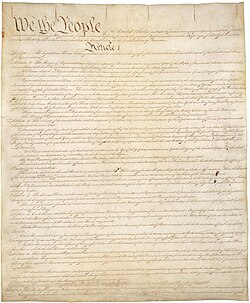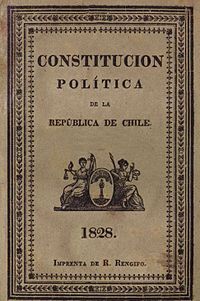Constitution
A constitution (from the Latin constitutio, -ōnis) is a codified text of a legal-political nature, issued by a constituent power, with the purpose of constituting a separation of powers, defining and creating the constituted powers (legislative, executive and judicial), which were previously united or intermingled, and their respective checks and balances (checks and balances), in addition to being the Fundamental law of a State, with a higher rank than the rest of the legal norms, founding —according to normativism— the entire legal system, includes the regime of the rights and freedoms of citizens, also delimiting the powers and institutions of the political organization.
Currently, it is also customary to add rules unrelated to the regulation of political power, depending on ideology, such as the foundations of the economic system. The constitution does not constitute the State or the nation, because both are already constituted prior facts. In political science, the States that have separation of powers are added to their form of State the term constitutional (as is the case of the constitutional monarchy or the constitutional republic). In the daily use of the term, constitution is called all the supreme laws of the States, even if they do not have a separation of powers. It is also used synonymously with magna carta, referring to a 1215 peace treaty that has greatly influenced Anglo-Saxon common law.
Classification
The constitution, like any legal norm, can be defined both from the formal point of view and from the material point of view. From the material point of view, the constitution is the set of fundamental rules that apply to the exercise of state power. From the formal point of view, the constitution is defined from the bodies and procedures involved in its adoption, thus deriving one of its main characteristics, supremacy over any other rule of the legal system.
Material definition
A material constitution is defined according to its rules and content, rather than a specific text or documents. Therefore, a material constitution is a set of rules that can be grouped into a single document, but not necessarily. These rules generally fall into one or more of the following categories:
- on the one hand, all the rules organized by the public authorities and their relations between them (government, parliament, president, king, etc.),
- On the other hand, public freedoms (or fundamental freedoms) can be granted to any person residing in the territory or national of the State concerned. In this last category, we often find rights or freedoms such as freedom to go and come, freedom of expression, etc.. This is the meaning of Article 16 of the Declaration of the Rights of Man and the Citizen of 1789:
"A society in which the guarantee of rights is not assured, nor the separation of powers determined, has no Constitution."National Constituent Assembly (France), 26 August 1789.
Most, if not all, states have a material constitution, in the sense that they have rules that organize and govern their political institutions.
According to its reformability
According to their reformability, constitutions are classified as rigid and flexible. Rigid constitutions are those that require a special and complex procedure for their reformability; that is, the procedures for the creation, reform or addition of constitutional laws are different and more complex than the procedures of ordinary laws.
- Semi-rigid, rigid or petrious constitutions
They are those constitutions that establish a more aggravated procedure than the ordinary legislative procedure to be modified. Depending on the degree of complexity of the same, they will be called rigid or semi-rigid.
In practice, written constitutions are also rigid constitutions; that is to say, when in a State we find that there is a written Constitution, we discover that it has a more complex procedure for reform or addition than the procedure for the creation, reform or addition of an ordinary law.
- Flexible constitutions
They are changed through the ordinary legislative procedure, which means that an Act of Parliament can change them at any time.
According to its origin
Constitutions are also differentiated based on their political origin: they can be created by contract between several parties, by imposition of one group on another, by sovereign decision, etc.
Constitutions Granted
The Constitutions granted are said to correspond traditionally to a monarchical State, where the sovereign himself is the one who precisely grants; that is, they are those in which the monarch, in his capacity as holder of sovereignty, grants them to the people. In this case, it is based on the following premises:
- From the perspective of the monarch, it is he who grants it, because it is the depositary of sovereignty.
- It is a relationship between the holder of sovereignty—monarca—and the people, who simply receive what the monarch says.
- This is a Constitution in which the rights for their subjects are recognized. with regard to the legislature.
Imposed constitutions
There are Constitutions that are imposed by Parliament on the monarch, referring to Parliament in a broad sense, which alludes to the representation of the political forces of the society of a State, of the real groups of power in a State that They are configured in a body called Parliament. In this type of Constitution, it is the representation of society that imposes a series of notes, determinations or political letters on the king, and he has to accept them. Therefore, in the case of imposed Constitutions, there is an active participation of the representation of society in fundamental political decisions.
Constitutions agreed upon
In the agreed Constitutions, the first idea that is had is consensus. Nobody grants them unilaterally, nor imposes them, because if they are imposed and not agreed upon, they would lack a framework of legitimacy. These Constitutions are multilateral, since everything that is agreed implies the will of two or more agents; therefore, they are contractual and it is said that they start from the theory of the social pact. Thus, it is possible to agree between counties, between provinces, between revolutionary factions, etc. The agreed or contractual constitutions imply
- greater political evolution than those imposed or granted
- There is a strong influence on the theory of the social pact
- in those that are agreed, this covenant or consensus can be given between various political agents or all those real power groups that are recognized by the State.
Thus, even in the case of a monarchy, when an agreement is made, the governed cease to be subjects and consecrate themselves as a sovereign people.
Constitutions approved by the will of popular sovereignty
They are those elected by the people of a State, which are generally announced by an assembly and reaffirmed with the maximum vote of the population in an electoral process. Therefore, it is not that society agrees with the holders of public power, but rather that the Constitution arises from social needs and popular force.
Sources of the constitution
Constituent Power: Sieyes recognizes that all citizens have the right to establish their government. But this government or the management of the general interests of the community is a human work and it is of paramount importance since the will of each and every one questions the well-being and freedom of all.
As a result, without an express mandate, legislators should not touch this great jurisdiction of the State that one calls the constitution.
This power is forbidden, with good reason, in ordinary assemblies, to avoid possible usurpations and certain agitations. And when it is necessary to touch the supreme law, people, sufficiently conscious, give a special mandate to a constituent assembly, to a convention, expressly charged, and excluding any other body, to review the constitution.
The primacy of the nation: Sieyes -unlike Rousseau- "is sustained by the rational and the constructed. The social state, in relation to the state of nature, perfects and ennobles man. It extends and protects freedom. Defends and guarantees equal rights".
For him, the true relations of a political constitution are «with the nation that remains» instead of «the generation that passes; with the needs of human nature, common to all, instead of individual differences. In What is the Third Estate? Sieyes proclaims: «Considered in isolation, the power of the citizens would be null, it resides only in the whole».
The nation does not create itself, it exists; it is a natural law, but it needs a political and administrative organization, or in the words of Sieyès a public establishment, that is, a set of means made up of people and things, destined to realize social ends:
The political constitution is after nation-wide formation. It comes when there is already a common will, before it.
Constitutionality control
Constitutionality control deals with the mechanisms for reviewing the adequacy of laws and State acts.
- Concentrated system: in some countries it is carried out by a Supreme Court or Constitutional Court, which is responsible for resolving the proposals or remedies of unconstitutionality presented by citizens against violations of any legal rule by the State, or by another individual.
- System concentrated in Supreme Court, system prevailing in Uruguay.
- System concentrated in Constitutional Court, case of validity in Bolivia.
- Diffuse System: This system states that the control of constitutionality of a rule or a legal act can be carried out by any court of the country. The lower judges have no handicap for this mechanism in respect of the Supreme Court of Justice of the Nation. Such is the case of the Argentine Republic, or the United States. However, it will be the highest court to decide whether the decisions of the lower courts are appealed.
- Mixed system.
- Diffuse control system in ordinary courts and concentrated control in the Supreme Court, as in Brazil.
- Diffuse control system in ordinary courts and concentrated control in the Constitutional Court, as in Peru and Colombia.
- Concentrated constitutionality control system in the Constitutional Court (preventive) and Supreme Court (repressive).
Classification according to the effect of the sentence
- The sentence may have effect only among the parties involved in the particular case. In this case it is said that the declaration of unconstitutionality has effect "parties".
- Or it can happen that the sentence is valid for all citizens, in which case it is said to have effect."erga omnes". This usually happens in countries where a concentrated control system is applied.
History of constitutionalism
It would be anachronistic to understand as modern constitutions the political systems of Greek Antiquity (Athenian democracy), the work of its legislators (logographers) or the legislative studies of its philosophers (Aristotle, Athenaion politeia —whose title is usually translated as Constitution of the Athenians—). The same can be said of the local or estate charters that were drawn up in medieval Europe or the Charter of Medina (Mohammed, year 2 of the Hegira —622 AD—)
Already in the context of the bourgeois revolutions of the Modern Age, some text has been retrospectively described as a "constitution," such as the Perpetual Law of the Kingdom of Castilla that they tried to promulgate the comuneros of the Junta de Ávila (1520). More importantly, the political regime established in the Netherlands in revolt since the end of the XVI century incorporates some characteristics of a constitutional system, although the texts it generated (Pacification of Ghent -1576-, Union of Utrecht -1579-) cannot be considered "constitutions". The English political regime gradually established since the end of the XVII century ("Glorious Revolution" and Bill of Rights of 1689 —John Locke's Treatisees on Civil Government are published that same year—) is based on common law, and is defined as a constitutional regime without a written constitution whose Precedents can be traced back to the Magna Carta of 1215, which in itself cannot be described as a "constitution", but is colloquially considered synonymous.
As a consequence of the enlightened criticism of the political systems of the Old Regime (the absolute or authoritarian monarchy), the current constitutions begin with the projects for Corsica and for Poland that Jean-Jacques Rousseau drafted in 1755 and 1771-1772 respectively; and, as a document that actually came into force, the United States Constitution (September 17, 1787, whose direct antecedent is the of the State of Virginia, 1776), establishing the limits of governmental powers, and that in its first amendments (Bill of Rights of December 15, 1791) protects fundamental rights and liberties.
The Declaration of the Rights of Man and of the Citizen approved by the French National Constituent Assembly (August 26, 1789), a precursor document of human rights, explicitly mentions in its article XVI the concept of constitution: "A society in which the guarantee of rights is not assured, nor the separation of powers determined, does not have a Constitution". The 19th century saw a constant development of this idea of constitution, division of powers and establishment of modern law as it is today. we know. Thus, with liberalism, constitutions materialize and develop (Ustawa Rządowa or Polish Constitution of May 3, 1791, French Constitution of September 3, 1791, Political Constitution of the Spanish Monarchy of March 19, 1812, etc.); designing very diverse political systems (Constitutional Act of the French People or "Constitution of the year I" -1793, a republican and democratic constitution, which recognized the right to work and to insurrection, and that did not come into force-, French Constitutional Charter of 1814 —a "granted charter" that did not recognize national sovereignty-).
Beyond civil and political rights, the introduction of so-called "second generation rights" (social rights) begins in the constitutions that emerged in the first third of the XX century (Political Constitution of the States United Mexican States of January 31, 1917, Soviet Constitution of July 10, 1918 —preceded by a Declaration of Rights of the Working and Exploited People—, Weimar Constitution of November 11, 1919, Spanish Constitution of 1931). Simultaneously, the fascist constitutions or pseudo-constitutions were promulgated (Italian Carta del Lavoro of 1927, German Enabling Law of 1933, Spanish Fundamental Laws of 1938-1967), characterized by not imposing limits on the power of the ruler.
The next fundamental milestone was the Second World War, after which the Universal Declaration of Human Rights (December 10, 1948) was produced, whose ratification by the different States gave it a certain value constitutional that some constitutions explicitly recognize.
Acknowledgment of rights
The fundamental norm is not only a norm that controls and structures power and its manifestations in a society, but it is also the norm that recognizes the rights that the State warns of all people. The Constitution does not grant rights, nor do the multiple declarations that have been pronounced internationally on the subject. Human rights are precedent to any State and superior to any expression of power that it has.
Until today, the process showed a development, thanks to which the initial model of the powerful and violent subject passed to the sovereign people and superior in their rights to any expression of the State. Today the powerful subject is not a person, but rather a dream created by the people and occupied by them according to the rules that they themselves established through a Constitution.
The most novel point of this development is given with the certainty that the mere declaration of rights does not make these invulnerable to any violation or attempted violation by both the State and other people. In this sense, the development of modern Constitutionalism is dedicated to the study of procedures that ensure adequate protection of recognized rights. Some of these procedures have a great historical and theoretical development (such as the habeas corpus which dates from the 13th century) and others are still new and have little development (such as habeas data and enforcement actions).
History of constitutionalism by country
- History of Argentine Constitutionalism
- History of Bolivian constitutionalism
- History of Cuban Constitutionalism
- History of Chilean Constitutionalism
- History of Colombian Constitutionalism
- History of Ecuadorian Constitutionalism
- History of Spanish Constitutionalism
- History of French constitutionalism
- History of Mexican Constitutionalism
- History of Panamanian constitutionalism
- History of Peruvian constitutionalism
- History of Venezuelan Constitutionalism
Contenido relacionado
Syria
MediaWiki:Noaffirmation
Copyright infringement



















